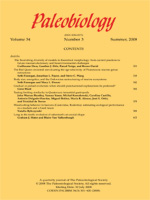Vertebrate tracks are a unique, abundant source of fossil data that supplements the skeletal record in many ways. However, the utility of ichnofossil data depends on how specifically the authors of tracks can be identified. Despite this fact, there is little consensus about how to identify potential trackmakers, and existing methods differ in their bases, assumptions, and corresponding implications.
In this paper we support the proposal that trackmakers should be identified primarily by skeletal structures that are both preserved in the ichnofossils and synapomorphies of some body-fossil clade. This synapomorphy-based technique enables certain taxa to be positively identified as candidate trackmakers and others to be excluded from consideration. In addition, the diagnostic level of the synapomorphy (i.e., to a higher or lower level) corresponds to that of the trackmaker. Additional features, such as body size and provenance, can be used in association with synapomorphies as additional differentiae of trackmaker identity.
Trackway analyses are dependent on the level of trackmaker diagnosis, but not all analyses require the same diagnostic specificity. Palichnostratigraphic correlations to the stage level are shown to require at least a genus-level identification of a trackmaker, whereas studies of vertebrate distributions (i.e., origins, extinctions, ranges) accommodate much coarser designations. Anachronistic occurrences of trace and body fossils result in range extensions for either the skeletal taxon or the feature in question. For example, the temporal distribution of theropods can be extended on the basis of the footprint record, resulting in an earlier estimated divergence time for Dinosauria.





